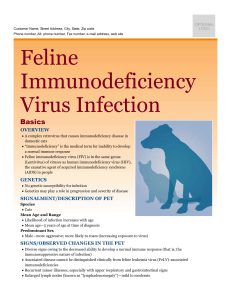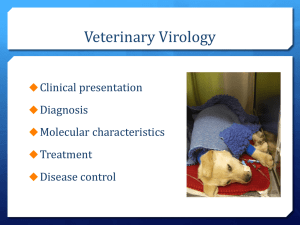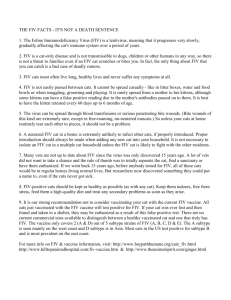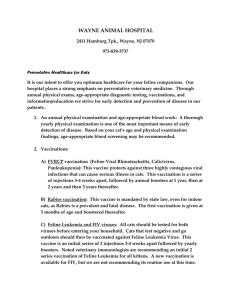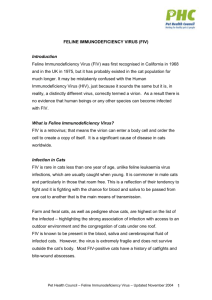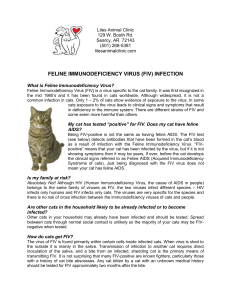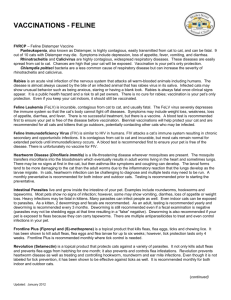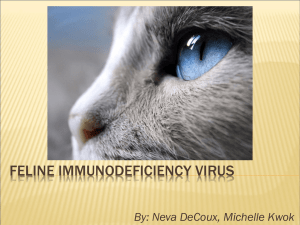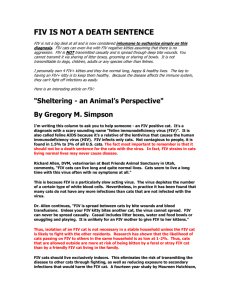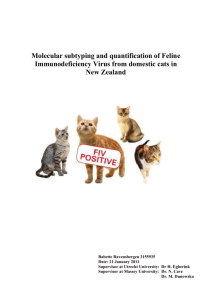File - KatieMontelongo
advertisement
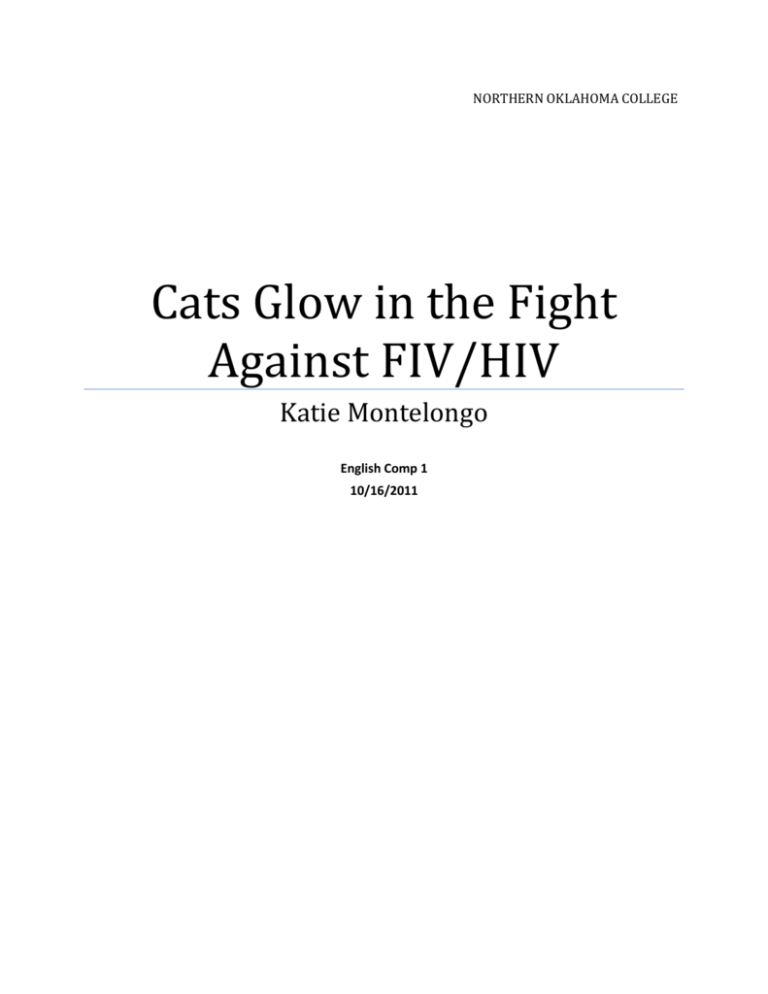
NORTHERN OKLAHOMA COLLEGE Cats Glow in the Fight Against FIV/HIV Katie Montelongo English Comp 1 10/16/2011 Montelongo 1 Glowing green and red cats really do exist! How are these special cats able to glow green or red? No, they did not fall into a container of nuclear waste. They are actually a result of gene manipulation or a hybrid. The end result of putting monkey, jellyfish and cat genes together are these glowing felines. The scientists that are responsible for these cats had a purpose in mind for making them glow. Their glowing genes help their species in the fight against feline immunodeficiency virus (FIV), and maybe even help with fight against the human disease, human immunodeficiency virus (HIV) one day. The plague of acquired immune deficiency syndrome (AIDS) not only affects humans, but cats and monkeys also. Scientists take a monkey gene, named rhesus, that is resistant to the virus and place it into an unfertilized feline egg. The egg is also infused with a jellyfish gene that glows green or red making the precious cells easier to see. The modified eggs are fertilized then placed into a normal mother cat, where they grow and go through the normal birth stages of an average cat. These cats can, now infused with rhesus, produce proteins that fight off feline immunodeficiency virus or FIV. Similar processes have been tested on mice, pigs, cows and marmoset monkeys. The tests were never successfully carried out on a carnivore until now. Using a virus to carry genes into an egg cell, that had worked in animals including mice and cows but never successful in a carnivore (Williams). These genetically altered cats could be the key to reducing or even eliminating the human virus HIV, similar to FIV, in the future. “It can help cats as much as people,” said Eric Poeschla, of the Mayo Clinic (Staff). How does feline immunodeficiency work? Feline immunodeficiency virus is a retrovirus and attacks the infected cat’s immune system. A retrovirus is a sneaky kind of virus that has an Montelongo 2 enzyme that changes their ribonucleic acid (RNA), the virus’s genetic information, into deoxyribonucleic acid (DNA). An animal’s DNA is where the genetic information is in the cell. The HIV virus infects T-cells that allow our bodies to fight off disease and illness. Once infected with HIV the T-cell is unable to fight off infections. The viral RNA strands, now changed into DNA strands, are inserted into the infected persons DNA and become part of the T-cells DNA. The infected and tainted T-cell unknowingly makes more viruses that repeat this process and go on to infect other cells ensuring a life with FIV. The final stage of FIV is similar to acquired immune deficiency syndrome (AIDS), where the body is unable to fight off cancer or even a common cold. During this final, clinical stage, the cat’s immune system is not functioning correctly since the virus kills essential cells in the system (Nash).Common bacteria, yeast, parasites, and viruses that usually do not cause serious disease in people with healthy immune systems can cause fatal illnesses in people with AIDS (AIDS-PubMed Health). How does FIV spread? FIV cannot be passed to humans, however, can be easily be passed to another cat by their bodily fluids. Biting is the most common way FIV is passed, but it can also be transferred through sharing litter boxes, food and water bowls. FIV is shed in the saliva and is usually transmitted by bite wounds (Nash). Kittens, though not common, can even get the virus from their mothers. FIV transmission in the utero or through the mother’s milk is very rare (Nash). This virus is quite common in the feline species, but thrives in free-roaming cats due to the fact that they acquire more bite wounds in fights than the normal house cat. FIV is found worldwide in domestic cats, and also infects wild felines including snow leopards, lions, tigers, jaguars, Florida panthers, and bobcats (Nash). There are some symptoms to look out for when a cat has FIV like loss of appetite, oral infections, swollen lymph nodes, and problems Montelongo 3 with their eyes and breathing. After a feline has FIV there is no cure, but with the help of the genetically modified cats there is hope to someday finding a cure. In conclusion, these unique glowing cats are not just interesting, but could also be the answer to finding a cure for FIV. Finding a cure for FIV can help find a cure for HIV due to the fact that the diseases are similar in the way they work. “One of the best things about this biomedical research is that it is aimed at benefiting human and feline health, “said Eric Poeschla, of the Mayo Clinic (Staff). The feline immunodeficiency virus spreads through the body of the feline and has no current cure, but with a cat full of modified genes to help we stand a chance. Scientist not only gets to help develop ways to find a cure for these horrible viruses, but also gets to work with glowing cats! I would have never thought cats that can glow could even exist let alone be so beneficial to the future. Montelongo 4 Works Cited "AIDS-PubMed Health." 9 June 2011. PubMed. 13 October 2011 <http://www.ncbi.nlm.nih.gov/pubmedhealth/PMH0001620/?report=printable>. Nash, Holly. Feline Immunodeficiency Virus. n.d. 13 October 2011 <http://www.peteducation.com/article.cfm?c=1+1316&aid=213>. Staff, IB Times. 'Green-Glowing' Cats May Help to Fight Against HIV/AIDS. 13 September 2011. 11 October 2011 <http://www.ibtimes.com/articles/213108/20110913/glowing-cats-mayo-clinicjapan-hiv-aids.htm>. Williams, Sarah C.P. Glowing Kittens Fight Feline AIDS. 11 September 2011. 11 October 2011 <http://news.sciencemag.org/sciencenow/2011/09/glowing-kittens-fight-feline-aid.html>.
